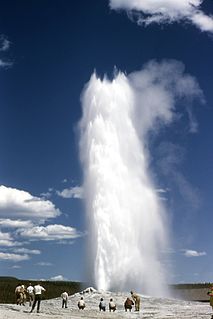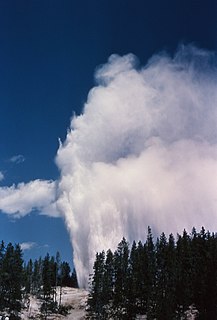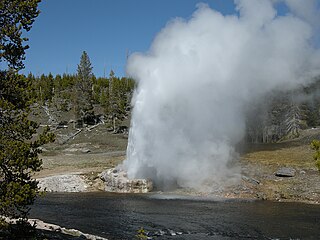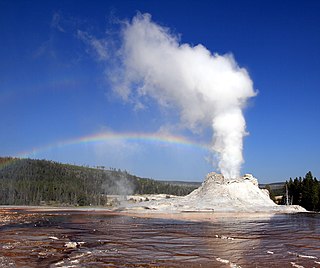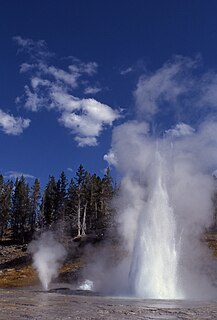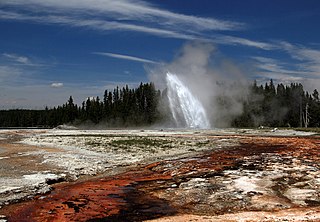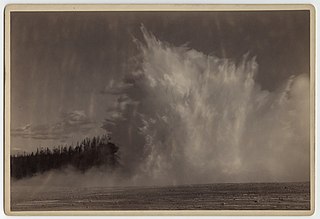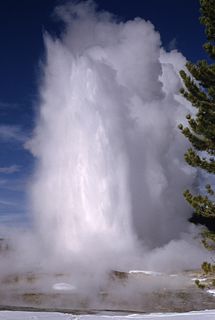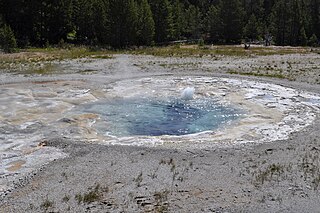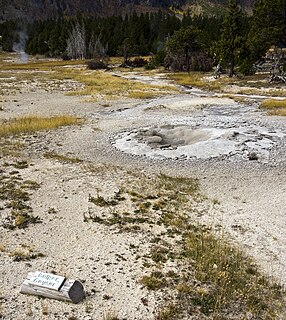| Semi-Centennial Geyser | |
|---|---|
| Location | Norris-Mammoth corridor, .25 miles (0.40 km) north of Roaring Mountain, Yellowstone National Park, Park County, Wyoming |
| Coordinates | 44°47′10″N110°44′24″W / 44.7861488°N 110.7398630°W Coordinates: 44°47′10″N110°44′24″W / 44.7861488°N 110.7398630°W [1] |
| Elevation | 7,533 feet (2,296 m) [1] |
| Type | Explosive-type Geyser (Fountain) |
| Eruption height | 300 ft (91 m) |
Semi-Centennial Geyser is located just north of Roaring Mountain in Yellowstone National Park in the U.S. state of Wyoming. [2] Situated next to the Grand Loop Road, the geyser was first noticed when it had a few small eruptions in 1919. A few years later at 6:40am on August 14, 1922 the geyser erupted in the first of a series of increasingly violent eruptions, which by the afternoon on the same day reports stated that the ejected water was exceeding 300 feet (91 m) in height. By the evening of the 14th, the geyser had scattered debris and rocks a distance of 450 ft (140 m) from the crater. Short lived, Semi-Centennial Geyser has been quiet since and a small pool of water now sits where the geyser erupted. [3] As the geyser showed its biggest activity in 1922, the 50th anniversary of the establishment of Yellowstone National Park in 1872, it was accorded the name of Semi-Centennial.

Roaring Mountain is in Yellowstone National Park in the U.S. state of Wyoming. Roaring Mountain was named for the numerous fumaroles on the western slope of the peak which during the early 1900s were loud enough to be heard for several miles. Roaring Mountain is 5 miles (8.0 km) north of Norris Geyser Basin and south of Obsidian Cliff and is easily seen from park roads.

Yellowstone National Park is an American national park located in Wyoming, Montana, and Idaho. It was established by the U.S. Congress and signed into law by President Ulysses S. Grant on March 1, 1872. Yellowstone was the first national park in the U.S. and is also widely held to be the first national park in the world. The park is known for its wildlife and its many geothermal features, especially Old Faithful geyser, one of its most popular features. It has many types of ecosystems, but the subalpine forest is the most abundant. It is part of the South Central Rockies forests ecoregion.

In the United States, a state is a constituent political entity, of which there are currently 50. Bound together in a political union, each state holds governmental jurisdiction over a separate and defined geographic territory and shares its sovereignty with the federal government. Due to this shared sovereignty, Americans are citizens both of the federal republic and of the state in which they reside. State citizenship and residency are flexible, and no government approval is required to move between states, except for persons restricted by certain types of court orders. Four states use the term commonwealth rather than state in their full official names.
